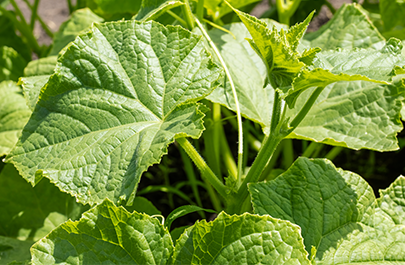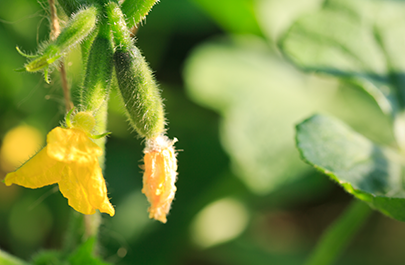






Cucumbers are among the oldest cultivated vegetables. Similar to tomatoes, they cannot tolerate rain, as the leaves rapidly become sick and the fruit can rot. Nevertheless, they regularly need a lot of water because they only have a shallow root system. Despite the temperature requirement, outdoor growing of cucumbers in particular for preserving cucumbers has proved successful in favourable locations. However, these are concentrated around the processing companies for preserved foods which are thus climate limited.
Salad cucumbers are produced almost exclusively in protected cultivation under foil or glass. The yields are more than twice as high as in open field cultivation. Cucumbers are susceptible to mildew and viruses like all plants in the pumpkin family. Varieties with resistance and/or tolerance to individual diseases are advantageous.
Cucumbers need a lot of nutrients and balanced fertilization. As a nutrient-depleting fruit, cucumbers need a lot of nitrogen. However, excessive amounts of nitrogen can increase the susceptibility to diseases. Cucumbers also have a constant demand for high volumes of water. They also need large amounts of potassium. Due to the continuous plant growth and the simultaneous formation of flowers and fruits, a balanced supply of nutrients is a challenge for the plant. Cucumber fertilization must consider the constant growth of new shoots, leaves, flowers and fruits, and on the other hand, the already growing fruits for optimal ripening. Excessive amounts of nitrogen in this phase can cause poorly formed fruits and a bitter taste. The amount as well as the composition of complex fertilizers must therefore be adapted to the stage of development of the cucumbers.
(Unit/t of production)
(Unit/t of production)
N
2
2
Very Sensitive
P2O5
1.2
1.2
Very Sensitive
K2O
3
3
Very Sensitive
CaO
1.8
1.8
Very Sensitive
MgO
0.5
0.5
Sensitive
SO3
0.3
0.3
Very Sensitive
TE
Iron chelate as a leaf fertilizer for heavy bearing crops; Observe molybdenum and manganese requirement
The table shows the uptake and withdrawal per tonne of cucumber yield. According to this, cucumbers mainly need nitrogen and potassium. Phosphorus and magnesium must also be present in appropriate amounts. For example, a cucumber yield of 200t/ha takes up 400kg N/ha. If 40kg N/ha are supplied by the soil, then 360kg N/ha would need to be fertilized. If grown outdoors with a fruit yield of 60-100t/ha and 20t plant mass, the following quantities of nutrients per hectare must be assumed: 145kg N, 55kg P2O5, 220kg K2O, 325kg CaO, and 55kg MgO.
First application

Second application

Third application

Start with moderate fertilization from planting until first flowering:
After planting and at the beginning of growth, cucumbers need relatively little fertilizer. Meagre fertilization and restrained irrigation increase root mass formation. Therefore, only about 10% of the nitrogen, 7% of the potash, and 40% of the total phosphorus are provided until the first flowering. An NPK compound fertilizer with a low N content is suitable for this fertilization phase.
Balanced nutrition for flowering and fruit formation from first flowering until first harvest:
Flowering and fruit formation have to be promoted at the same time. Therefore, particularly balanced nutrient ratios are necessary. During this phase, fertilization is high in potassium. Magnesium and calcium supply must also be taken into account.
Application of K-heavy NPK fertilizer from the start of harvest until the end of cultivation.
The harvesting phase has the highest nutrient requirements. High amounts of nitrogen, phosphate and potash are necessary. A continuous dosage of nutrients through irrigation (fertigation) with suitable L.A.T products ensures the supply. Poorly formed fruits with a bad taste are the result of of inadequate fertilization. In addition, undersupply is also evidenced by poorer new flower formation and the resulting reduced yield. Cucumber fertilization can be stopped approximately two weeks before the end of the harvest. The last fruits then ripen with the nutrients still present in the plants.
LAT Nitrogen Austria GmbH
St.-Peter-Strasse 25
4021 Linz, Austria











